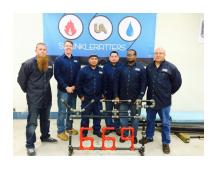In my last column, I talked a bit about “blue-collar” occupations and broke down some of the pathways into those careers. This week I’d like to talk in a bit of detail about another such potential pathway: apprenticeships.
As an apprentice, you’re taken on by a company and learn how to perform in your occupation through on-the-job training (OJT). In that training period, under experienced supervision, you’ll not only learn everything there is to know about your career, but you’ll also be earning a paycheck while you learn. Though the length of apprenticeships differ according to the type of job, you can expect to gradually move up the pay scale, and gain great benefits.
Employers or unions generally pay a reduced OJT/apprenticeship wage — generally 40 percent to 50 percent of “journeyman” wages. But veterans in an approved program can use their GI Bill benefits to support their apprenticeship training and receive a tax-free stipend to boot. The Post-9/11 GI Bill stipend for this purpose equals the monthly housing allowance for an E-5 with dependents, which is paid on top of the entry-level wage.
That can be a significant payment — the current monthly military housing allowance rate for an E-5 with dependents in San Diego, for example, is $2,052. In Atlanta, it’s $1,326, and in Houston, $1,701. The stipend drops by 20 percent every six months as the vet’s wages regularly rise until he or she attains journeyman status and pay.
Check out www.benefits.va.gov/gibill/onthejob_apprenticeship.asp for further information and contact your local VA office with any questions.
A typical apprenticeship lasts three to five years, but some bring applicants in at a higher level and complete their training in less time. Although there are many apprenticeship opportunities throughout the country, it’s always beneficial to connect with those that work directly with veterans. Here are three such organizations that have developed apprenticeship programs specifically for veterans:
■ Helmets to Hardhats (www.helmetstohardhats.org) focuses on careers in the building and construction fields. No prior experience is required; this program will teach you all you need to know to build a career in a specialized skilled construction craft.
■ The United Association’s Veterans in Piping (www.uavip.org) focuses on plumbing and pipefitting trades. This program is open to military personnel who are preparing to leave the service and are stationed at a participating installation. No experience is needed.
■ The Painters and Allied Trades Veterans Program (http://pat-vp.org) focuses on careers in construction-related “finishing trades,” including industrial painting, commercial painting and wallcovering, drywall finishing, floor covering installation, and glass/glazing and architectural metalwork. This organization’s “Earn While You Learn” program offers a mix of OJT and classroom instruction at no cost to veterans, which means they can save their GI Bill benefits for future use.
These three groups have a variety of opportunities and are ready to train and put transitioning veterans to work in rewarding careers.
Here are two sources for much more background information on apprenticeships and what they can do for you:
■ At www.mynextmove.org/find/apprenticeship, you can find information on apprenticeships in more than 300 career fields— including some that you might never expect would have such programs.
■ The Labor Department also has a website with information on apprenticeships specifically aimed at transitioning service members and veterans at www.doleta.gov/oa/veterans.cfm.
In my next column, I’ll be talking to a representative from Helmets to Hardhats for a deeper look at apprenticeships.
Steven Maieli is the founder of http://transitioningveteran.com/, which highlights links to federal, state, for-profit and nonprofit veterans benefits and other resources. He also writes a blog on transitioning veterans’ issues at www.transitioningveteran.com/wordpress.

























Comments